Framework for study of performance of pursuit algorithms¶
Experimental study of pursuit algorithms for sparse recovery needs following components:
- Generation of synthetic sparse representations
- Generation of synthetic compressible representations
- Addition of measurement error
- Measurement of recovery error
- Phase transition diagrams
sparse-plex library provides a wide variety of functions
to help with the study of pursuit algorithms.
Generation of synthetic sparse representations¶
A sparse representation is constructed in an appropriate representation space.
The class spx.data.synthetic.SparseSignalGenerator provides various
methods for generating synthetic sparse representations from different
distributions.
- Uniform
- Bi-uniform
- Gaussian
- Complex Gaussian
- Rademacher
- Bi-Gaussian
- Real spherical rows
- Complex spherical rows
It takes following parameters:
\(N\)
The dimension of the representation space
\(K\)
The sparsity level of representations
\(S\) (optional)
Number of sparse representations to generate with a common support. Default value is 1.
The generator first uniformly selects a random support of \(K\) indices from the index set \([1, N]\).
After that it provides various ways to generate the non-zero values.
Uniform¶
We create the sparse signal generator instance:
N = 32;
K = 4;
gen = spx.data.synthetic.SparseSignalGenerator(N, K);
We generate a sparse vector:
rep = gen.uniform();
Let’s plot it:
stem(rep, '.');
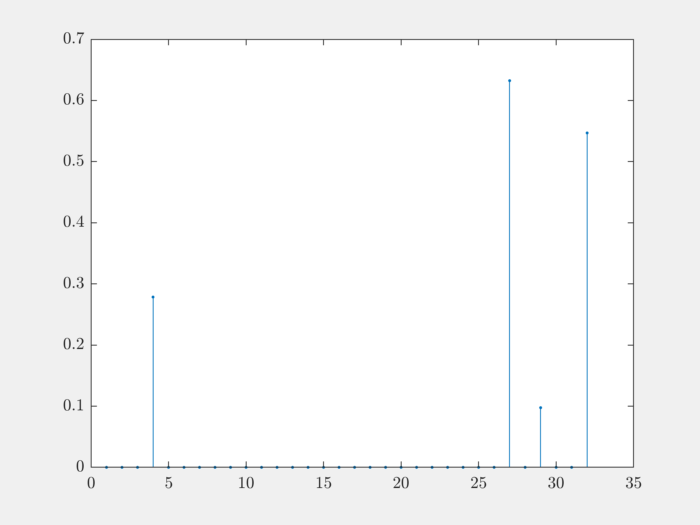
Note that all non-zero entries are positive and they are distributed uniformly between \([0, 1]\).
We can easily identify the support for the representation:
>> spx.commons.sparse.support(rep)'
ans =
4 27 29 32
The \(\ell_0\)-“norm” can be calculated easily too:
>> spx.commons.sparse.l0norm(rep)
ans =
4
Let’s cross-check with the support used by the generator:
>> gen.Omega
ans =
27 29 4 32
By default, non-zero values are chosen between the range \([0, 1]\).
We can specify a custom range \([a, b]\) by calling:
rep = gen.uniform(a, b);
Bi-uniform¶
The problem with previous example is that all non-zero entries are positive. We would like that the sign of non-zero entries also changes with equal probability. This can be achieved using bi-uniform generator.
- The non-zero values are generated using uniform distribution.
- A sign for each non-zero entry is chosen with equal probability.
- The sign is multiplied to the non-zero value.
The setup steps are same:
N = 32;
K = 4;
gen = spx.data.synthetic.SparseSignalGenerator(N, K);
The representation generation step changes:
rep = gen.biUniform();
Plotting:
stem(rep, '.');
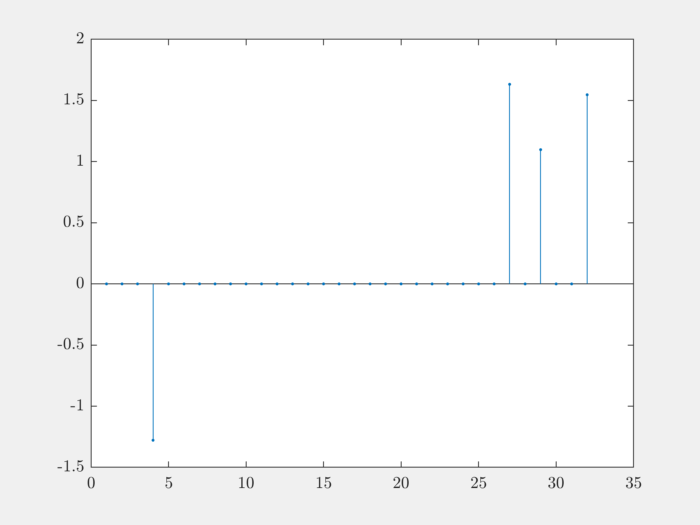
We will generate the magnitudes between 2 and 4:
rep = gen.biUniform(2, 4);
Plotting:
stem(rep, '.');
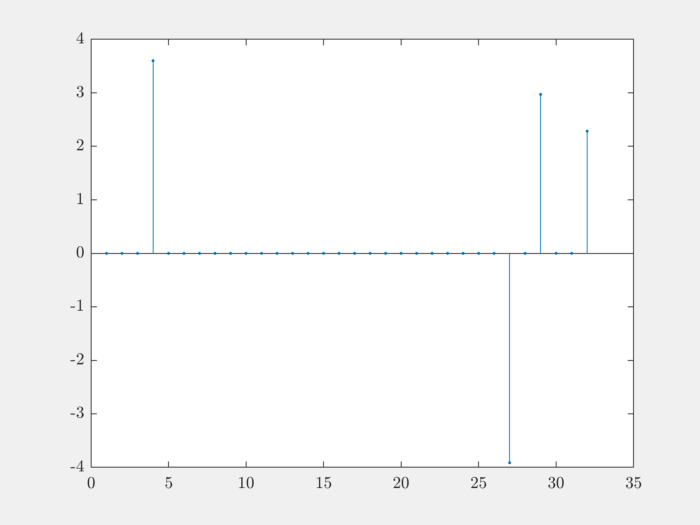
Gaussian¶
Let’s increase the dimensions of our representation space and sparsity level:
N = 128;
K = 8;
gen = spx.data.synthetic.SparseSignalGenerator(N, K);
Let’s generate non-zero entries using Gaussian distribution:
rep = gen.gaussian();
Plot it:
stem(rep, '.');
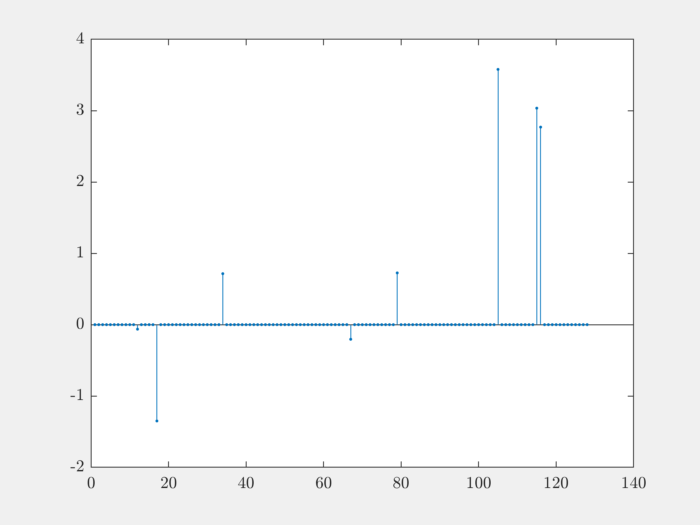
Bi-Gaussian¶
While the non-zero values in Gaussian distribution have both signs, we can see that some of the non-zero values are way too small. These are problematic for those sparse recovery algorithms which are not very good with way too small values or which demand that the dynamic range between the large non-zero values and small non-zero values shouldn’t be too high. The small non-zero values are also problematic in the presence of noise as it is hard to distinguish them from noise.
To address these concerns, we have a bi-Gaussian distribution.
The way it works is as follows:
- Generate non-zero values using Gaussian distribution.
- Let a value be \(x\).
- Let an offset \(\alpha > 0\) be given.
- If \(x > 0\), then \(x = x + \alpha\).
- If \(x < 0\), then \(x = x - \alpha\).
Default value of offset is 1.
Setup:
N = 128;
K = 8;
gen = spx.data.synthetic.SparseSignalGenerator(N, K);
Generating the representation vector:
rep = gen.biGaussian();
Plot it:
stem(rep, '.');
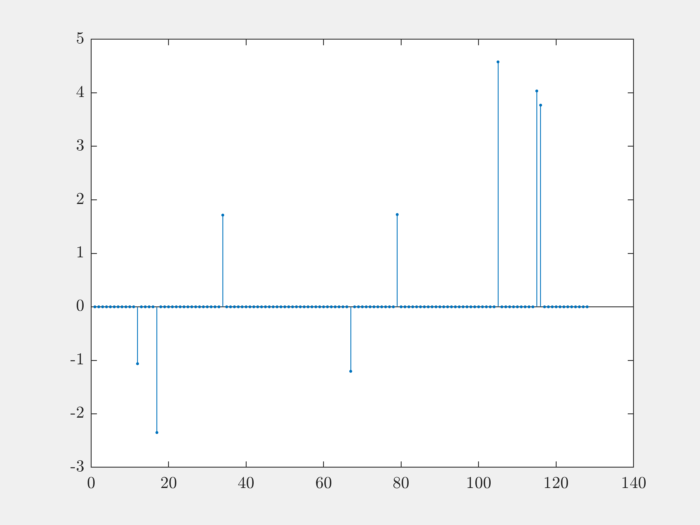
Let’s pickup the non-zero values from this vector:
>> nz_rep = rep(rep~=0)'; nz_rep
nz_rep =
-1.0631 -2.3499 1.7147 -1.2050 1.7254 4.5784 4.0349 3.7694
Let’s estimate the dynamic range:
>> anz_rep = abs(nz_rep);
>> dr = max(anz_rep) / min(anz_rep)
dr =
4.3068
The bi-Gaussian distribution is quite flexible.
- The non-zero values are both positive and negative.
- Quite large non-zero values are possible (though rare).
- Too small values are not allowed.
- Dynamic range between largest and smallest non-zero values is not much.
Rademacher¶
Sometimes, you want a sparse representation where the non-zero values are either \(+1\) or \(-1\). In this case, the non-zero values should be drawn from Rademacher distribution.
Setup:
N = 128;
K = 8;
gen = spx.data.synthetic.SparseSignalGenerator(N, K);
Generating Rademacher distributed non-zero values:
rep = gen.rademacher();
Plot it:
stem(rep, '.');
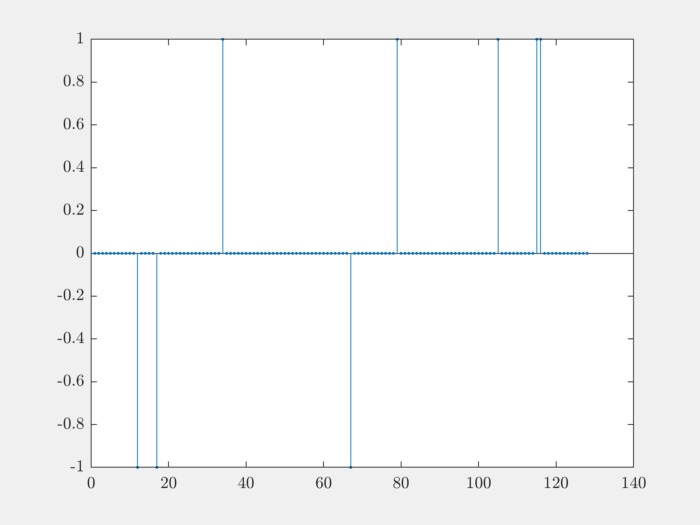
Generating compressible signals¶
[Cev09] describes a set of probability distributions, dubbed compressible priors whose independent and identically distributed realizations result in p-compressible signals.
The authors provided a Matlab function randcs.m
for generating compressible signals. It is included
in sparse-plex.